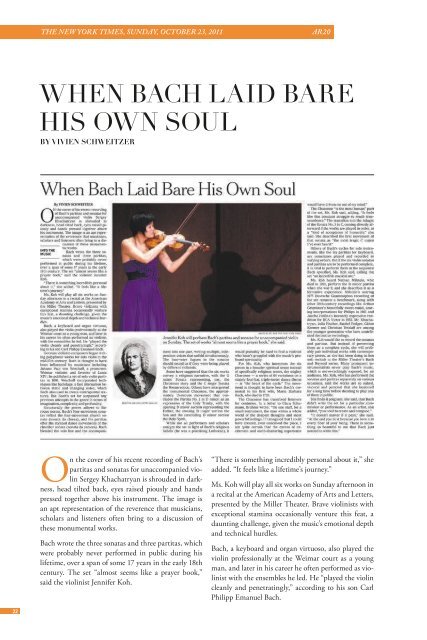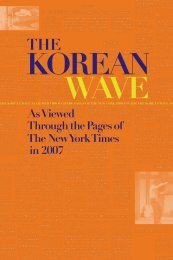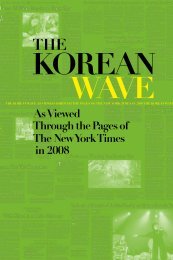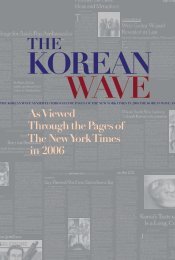The Korean Wave 2010-2011 - Korean Cultural Service
The Korean Wave 2010-2011 - Korean Cultural Service
The Korean Wave 2010-2011 - Korean Cultural Service
You also want an ePaper? Increase the reach of your titles
YUMPU automatically turns print PDFs into web optimized ePapers that Google loves.
<strong>The</strong> New York Times, Sunday, October 23, <strong>2011</strong>AR20When Bach Laid BareHis Own SoulBy VIVIEN SCHWEITZEROn the cover of his recent recording of Bach’spartitas and sonatas for unaccompanied violinSergey Khachatryan is shrouded in darkness,head tilted back, eyes raised piously and handspressed together above his instrument. <strong>The</strong> image isan apt representation of the reverence that musicians,scholars and listeners often bring to a discussion ofthese monumental works.Bach wrote the three sonatas and three partitas, whichwere probably never performed in public during hislifetime, over a span of some 17 years in the early 18thcentury. <strong>The</strong> set “almost seems like a prayer book,”said the violinist Jennifer Koh.“<strong>The</strong>re is something incredibly personal about it,” sheadded. “It feels like a lifetime’s journey.”Ms. Koh will play all six works on Sunday afternoon ina recital at the American Academy of Arts and Letters,presented by the Miller <strong>The</strong>ater. Brave violinists withexceptional stamina occasionally venture this feat, adaunting challenge, given the music’s emotional depthand technical hurdles.Bach, a keyboard and organ virtuoso, also played theviolin professionally at the Weimar court as a youngman, and later in his career he often performed as violinistwith the ensembles he led. He “played the violincleanly and penetratingly,” according to his son CarlPhilipp Emanuel Bach.German violinist-composers began writingpolyphonic works for solo violin in the mid-17th century. Bach is thought to have beeninfluenced by musicians including Johann Paul vonWesthoff, a prominent Weimar violinist and favoriteof Louis XIV; he published a set of solo violin partitasin 1696. Westhoff incorporated techniques likebariolage, a fast alternation between static and changingnotes, which Bach also used to create contrapuntaltextures. But Bach’s set far surpassed any previous attemptsin the genre in terms of imagination, complexityand profundity.Structurally the pieces adhere to Baroque norms.Bach’s four-movement sonatas reflect the four-movementchurch sonata (sonata da chiesa), and his partitasoffer the stylized dance movements of the chambersonata (sonata da camera). Bach blended the solo lineand the accompaniment into one part, writing multiple,independent voices that unfold simultaneously.<strong>The</strong> four-voice fugues in the sonatas should sound as ifthey were being played by different violinists.Some have suggested that the six works convey a religiousnarrative, with the G minor Sonata representing,say, the Christmas story and the C major Sonata theResurrection. Others have interpreted the monumentalChaconne, the approximately 15-minute movementthat concludes the Partita No. 2 in D minor, asan expression of the Holy Trinity, with the openingD minor section representing the Father, the ensuingD major section the Son and the concluding D minorsection the Holy Spirit.While not all performers and scholars analyze the setin light of Bach’s religious beliefs (he was a practicingLutheran), it would probably be hard to find a violinistwho hasn’t grappled with the music’s profoundspirituality.For Ms. Koh, who interprets the six pieces in a broaderspiritual sense instead of specifically religious terms,the mighty Chaconne — a series of 64 variations ona stately four-bar, triple-meter dance theme — is “theheart of the cycle.” <strong>The</strong> movement is thought to havebeen Bach’s memorial to his first wife, Maria BarbaraBach, who died in 1720.<strong>The</strong> Chaconne has transfixed listeners for centuries. Ina letter to Clara Schumann, Brahms wrote: “On onestaff, for a small instrument, the man writes a wholeworld of the deepest thoughts and most powerful feelings.If I imagined that I could have created, evenconceived the piece, I am quite certain that the excessof excitement and earth-shattering experience wouldhave driven me out of my mind.”<strong>The</strong> Chaconne “is the most human” part of the set,Ms. Koh said, adding, “It feels like this constantstruggle to reach transcendence.” <strong>The</strong> transition intothe Adagio of the Sonata No. 3 in C, coming directlyafterward if the works are played in order, is a “kind ofacceptance of humanity,” she said. She described thefirst movement of that sonata as “the most tragic Cmajor I’ve ever heard.”Others of Bach’s cycles for solo instruments, like thesix partitas for keyboard, are sometimes played and recordedin varying orders. But if the six violin sonatasand partitas are to be performed complete, it is vitalto perform them in the sequence Bach specified, Ms.Koh said, calling the set “an incredible musical arc.”Ms. Koh heard Nathan Milstein, who died in 1992,perform the D minor partita when she was 9, and shedescribes it as a formative experience. Milstein’s searing1975 Deutsche Grammophon recording of the setremains a benchmark, along with other 20th-centuryrecordings like Arthur Grumiaux’s beautifully sweettoned,soaring interpretations for Philips in 1961 andJascha Heifetz’s intensely expressive rendition for RCAVictor in 1952. Mr. Khachatryan, Julia Fischer, RachelPodger, Gidon Kremer and Christian Tetzlaff areamong the younger generation who have contributeddistinctive recordings.Ms. Koh would like to record the sonatas and partitas.But instead of presenting them as a complete cycle, shewill probably pair individual works with contemporarypieces, as she has been doing in her solo recitalsin the Miller <strong>The</strong>ater’s Bach and Beyond series. Manyprominent instrumentalists never play Bach’s music,which is nerve-rackingly exposed, for an audience. Ms.Koh, who has performed the sonatas and partitas separatelyon various occasions, said the works are so naked,visceral and personal that she hesitated for a longtime before deciding to play any of them in public.She finds it poignant, she said, that Bach didn’t write theset for a particular commission or performance. As anartist, she added, “you need to create and compose.”“It doesn’t matter if it pays,” she said. “At the end youdo it because you love it in every fiber of your being.<strong>The</strong>re is something so beautiful to me that Bach justneeded to write this.”22Copyright © <strong>2011</strong> by <strong>The</strong> New York Times Co. Reprinted with permission.23





